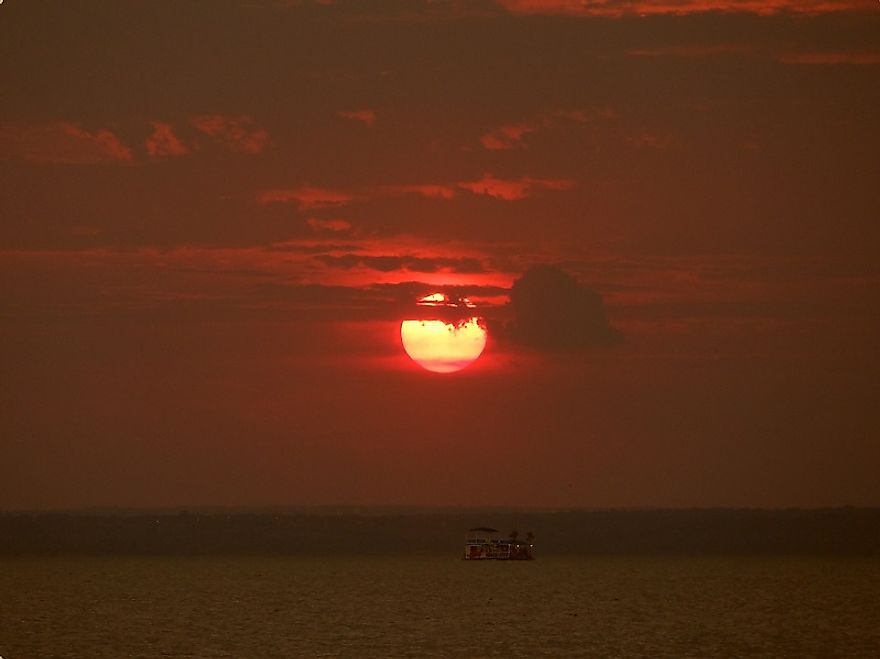The Tocantins River

5. Description
The 2,640-kilometer long Brazilian Tocantins River flows in a south to north direction through the four Brazilian states of Goiás, Tocantins, Maranhão, and Pará. Though many tend to confuse it as a tributary of the Amazon, the Tocantins actually forms a separate drainage basin, and one which is around 800,000 square kilometers in size. The river arises from its headwaters in the central plateau in the Goiás state of Brazil, and ultimately drains into the Atlantic Ocean. The Araguaia, Maranhão, and Paranatinga rivers are some of the major tributaries of the Tocantins River. In the Tupi language, an extinct language of the Tupí people of Brazil, the name of the Tocantins River meant the ‘toucan’s beak’.
4. Historical Role
A long time ago, the Tocantins River Basin was inhabited by several indigenous tribes of South America, including the Tocantin, Guaraju, Apinage, Inhaiguara, and others. With the arrival of the Europeans on the continent, European explorers gradually discovered their way through the waterways into this river. The French explorers La Blanjartier and, later, La Ravardière, were the first Europeans to access the Tocantins River, doing so in 1610 and 1613, respectively. They managed to access the river through what is now the Brazilian state of Maranhão. In the later 17th and 18th Centuries, several expeditions were carried out to explore the Tocantins and raid the native Indian settlements of the region, and subsequently establish European supremacy over them.
3. Modern Significance
11 distinct indigenous ethnic tribes of South America still have members who are settled along the banks of the Tocantins River and its tributaries. Though the population is low, totaling only around 14,000 people, the extreme diversity and indigenous nature of the population is anthropologically quite significant. Nearly 300 fish species, including many endemic species, have been identified in the Tocantins-Araguaia River systems as well. Fishing in the waters of these river systems sustains the livelihoods of the people settled near it. The Tucuruí Dam, an concrete gravity dam built on the Tocantins River, has an installed capacity of 8,370 Megawatts. The presence of the dam, however, restricts the navigation on the Tocantins River. Rapids and waterfalls along the river also impede the movement of waterway traffic along the river.
2. Habitat
Biodiversity in and around the drainage basin of the Tocantins River is quite high, although not as high as the land drained by the Amazon. The vegetation pattern of the Tocantins River basin primarily is comprised of evergreen tropical rain forests which are dominated by tall trees and dense undergrowth in the lowlands towards the northern reaches of the river. This transitions into sub-montane dense forests and sub-montane open forests towards the southern reaches of the river. Liana forests occupy large areas in the higher southern reaches of the Tocantins and its upper tributaries as well. More than 90 species of bats populate this region, while 527 bird species also thrive here, and these include macaws, parrots, parakeets, and certain birds of prey. Eight species of primates, like the bearded saki, tiny titi monkey, and spider monkey, and such other mammals as the Brocket deer, pumas, tapirs, and armadillos, can also be spotted in the tropical forests of the region. Aquatic species found in the Tocantins River Basin include aquatic mammals like the Amazonian manatee, tucuxi, and Araguaian river dolphin. These live near more than 350 fish species, 175 of which are endemic, like the Pleco catfish and South American killifish, and reptiles like the Black and the Spectacled caimans and yellow spotted river turtles.
1. Threats and Disputes
Construction of large-scale dam projects on the Tocantins and Araguaia Rivers poses the biggest threat to the lives of the local indigenous communities, as well as the flora and fauna of this river system. A large number of dams already exist on these two rivers, and many more are planned to be constructed in the future years. These dams have had disastrous impacts on the biodiversity of the region, and consequently affected the local fisheries and the livelihoods of people dependent on the river for their sources of food and income. The plans to blast out rocky shores along the river, meant to make way for clear channels through it by which to facilitate navigation, also threatens the future of the river and its inhabitants. Anthropogenic fires, extensive deforestation for the expansion of human settlements, indiscriminate cattle ranching activities, and the felling of trees for logging are the other major ongoing threats to the Tocantins River's ecosystems.











